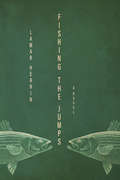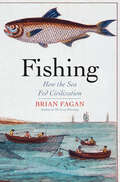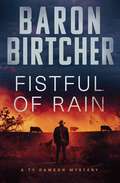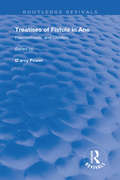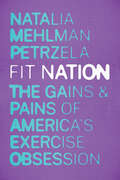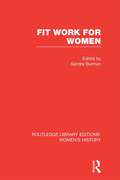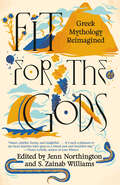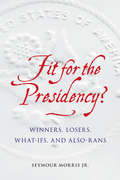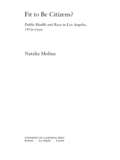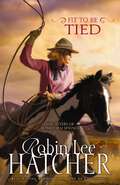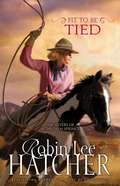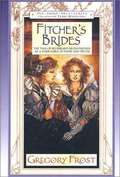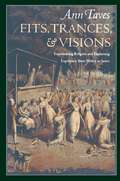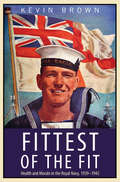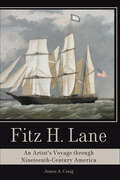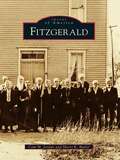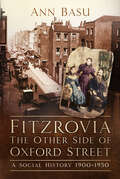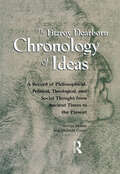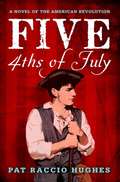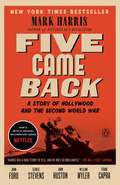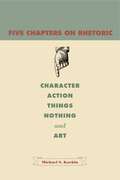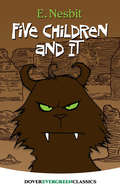- Table View
- List View
Fishing the Jumps: A Novel
by Lamar HerrinFrom the author of Romancing Spain, a novel about two fishing buddies and about home, family, and the stories we tell to keep the illusion alive.In his latest novel, award-winning writer Lamar Herrin highlights the art of storytelling and the value of friendship with a lush, outdoor landscape serving as a backdrop. Set over the course of a weekend spent fishing on an Adirondack lake, two middle-aged friends—Jim McManus and Walter Kidman—sip Jim Beam on the rocks and share stories of memory and camaraderie as the past and present meld to reveal that what happens in the past rarely stays there.Herrin explores the kaleidoscopic effect of memory while examining the rise and fall of life in the South. Presented is a story about a displaced southerner who tells the account of a family whose fortune was made in the post-World War II apparel industry, but it is the extended family that claims the narrator’s attention and sympathy, the grandparents, the aunts and uncles and cousins, and the stories told and retold about those family members until they reach the status of myth. It is a novel of two lakes—the small glacial one where Jim and Walter fish and exchange stories, and the southern one, created when a dam was built and numerous mountain settlements were flooded. It is a novel chronicling the aftermath of World War II, who won what, and when the time comes, who stands to lose.Lyrical and poetic yet playful and entertaining, Fishing the Jumps is more than just fishing tales. It is a seamless and haunting novel that is ultimately a story of the deep and necessary relationship between two men and the binding and nourishing effect of family—not only of an extended family, but of a whole community, and in fact, a whole region.Praise for Fishing the Jumps“Deliberate and gorgeous, with a mastery of description and a searing command of American culture. Fishing the Jumps is quiet, thoughtfully told, but with a thrashing undercurrent . . . . What seems almost a low-key dialogue on a placid lake is actually a turbulent family history that refuses to sink to the bottom of memory. This makes an elegant structure for a fish story that plumbs the nature of storytelling itself. It is a thrilling, intense novel to read. I was hooked.” —Bobbie Ann Mason, author of Patchwork and The Girl in the Blue Beret“Herrin’s writing is vivid, lyrical, and intense. But the glory of this novel is Herrin’s gift for recreating a particular time and place, the decades after WWII, the exuberance of summers by the mountain lake, the brilliance of Little Howie Whalen building a textile empire. These characters, and this time, come alive in a way that haunts the reader.” —Robert Morgan, author of Gap Creek“Lamar Herrin may be the best writer of whom you have never heard . . . there’s no denying that Fishing the Jumps is a work of genius . . . Herrin’s narrative style is seamless, his emotional intelligence expert. . . . [A] bildungsroman, a mystery, and a prose poem, too, in its lush, layered honesty, verbal ingenuity, and elegant humanity.” —Linda Elisabeth LaPinta, Kentucky Humanities
Fishing: How the Sea Fed Civilization
by Brian FaganAn archaeologist examines humanity&’s last major source of food from the wild, and how it enabled and shaped the growth of civilization.In this history of fishing—not as sport but as sustenance—archaeologist and best-selling author Brian Fagan argues that fishing was an indispensable and often overlooked element in the growth of civilization. It sustainably provided enough food to allow cities, nations, and empires to grow, but it did so with a different emphasis. Where agriculture encouraged stability, fishing demanded movement. It frequently required a search for new and better fishing grounds; its technologies, centered on boats, facilitated movement and discovery; and fish themselves, when dried and salted, were the ideal food—lightweight, nutritious, and long-lasting—for traders, travelers, and conquering armies. This history of the long interaction of humans and seafood tours archaeological sites worldwide to show readers how fishing fed human settlement, rising social complexity, the development of cities, and ultimately the modern world.&“A tour-de-force . . . Achieves its goal of putting fishing on par with hunter-gathering and agriculture in the history of human civilization.&” —Leon Vlieger, Natural History Book Service &“A valuable book as well as an interesting one . . . Fagan succeeds in providing an admirable primer for the enthusiast and a welcome tool for the historian.&” —Economist&“A unique panoramic survey of the field.&” —Laurence A. Marschall, Natural History&“Gently scholarly, elegant . . . A compelling picture of how fishing was so integral in each society&’s development. A multilayered, nuanced tour of &“fishing societies throughout the world&” and across millennia.&” —Kirkus Reviews
Fission and Fusion of Allies: The ROK Nuclear Quest and U.S.–France Competition and Cooperation
by Jooyoung Lee Lyong ChoiThis book traces the development of U.S-led global nuclear non-proliferation diplomacy during the three decades since the Eisenhower’s “Atoms for Peace” in 1953. The U.S. non-proliferation efforts had diverse obstacles. It had to prevent nuclear states’ export of nuclear technology while dissuading non-nuclear states from developing nuclear weapons. In addition, building non-proliferation regime was not always its top foreign policy priority. To understand the complex process of non-proliferation, the book examines the relations among three different actors in the nuclear field: a global non-proliferation regime builder (U.S.), a potential nuclear proliferator (France) and a would-be nuclear state (Republic of Korea). In tracing how they developed nuclear strategies, conflicting and compromising with one another, the book pays special attention to how the transforming Cold War structure in the 1970s not only affected foreign policies of the involved countries but also complicated their relationship. The exploration ultimately highlights the multidimensional nature of international discussion on nuclear non-proliferation as the ROK’s nuclear development attempts, U.S. non-proliferation efforts, and the U.S.-France nuclear technology cooperation in the 1970s were all deeply connected.
Fistful of Rain (The Ty Dawson Mysteries)
by Baron BirtcherThe second Sheriff Dawson mystery has &“lots of twists and turns that stretch back over years, then a mind-blowing ending that puts everything into place&” (Killer Nashville). Winner—2019 Best Book of the Year, Killer Nashville Ty Dawson, now the sheriff of Oregon&’s Meriwether County, is ready to put a trying year behind him, but he&’s afforded no such luck. In a country still coming to grips with the Vietnam War, Watergate, and Charles Manson, Ty&’s neck of the woods isn&’t safe from the turmoil—especially when a commune of young so-called hippies springs up out of nowhere . . . A longtime local sheep rancher accuses the Rainbow Ranch residents of livestock theft, putting Ty in the middle of a culture clash. Though Ty finds no evidence of a crime, the rancher brings in his own stock detective. Behind fences topped with razor wire, the commune and its enigmatic guru hold secrets of their own—many of which have nothing to do with peace, love, and understanding. Tensions flare, setting off a bloody wave of violence that will forever scar the place Ty calls home, unless he can stop it. &“Elegantly written . . . Ty may strike some readers as almost too smart, too well educated, and too pedantic for a small-town sheriff, but his insights into 1970s social issues make him an irresistible spokesman for the era.&” —Publishers Weekly &“A modern Western . . . The characters are well developed, and place descriptions make it easy to visualize the landscapes.&” —New York Journal of Books
Fistula in Ano: Haemorrhoids and Clysters (Routledge Revivals)
by John ArdernePublished in 1910. Treatises of Fistula in Ano discusses Medicine during the early 15th century.
Fit Nation: The Gains and Pains of America's Exercise Obsession
by Natalia Mehlman PetrzelaHow is it that Americans are more obsessed with exercise than ever, and yet also unhealthier? Fit Nation explains how we got here and imagines how we might create a more inclusive, stronger future. If a shared American creed still exists, it’s a belief that exercise is integral to a life well lived. A century ago, working out was the activity of a strange subculture, but today, it’s almost impossible to avoid exhortations to exercise: Walk 5K to cure cancer! Awaken your inner sex kitten at pole-dancing class! Sweat like (or even with) a celebrity in spin class! Exercise is everywhere. Yet the United States is hardly a “fit nation.” Only 20 percent of Americans work out consistently, over half of gym members don’t even use the facilities they pay for, and fewer than 30 percent of high school students get an hour of exercise a day. So how did fitness become both inescapable and inaccessible? Spanning more than a century of American history, Fit Nation answers these questions and more through original interviews, archival research, and a rich cultural narrative. As a leading political and intellectual historian and a certified fitness instructor, Natalia Mehlman Petrzela is uniquely qualified to confront the complex and far-reaching implications of how our contemporary exercise culture took shape. She explores the work of working out not just as consumers have experienced it, but as it was created by performers, physical educators, trainers, instructors, and many others. For Petrzela, fitness is a social justice issue. She argues that the fight for a more equitable exercise culture will be won only by revolutionizing fitness culture at its core, making it truly inclusive for all bodies in a way it has never been. Examining venues from the stage of the World’s Fair and Muscle Beach to fat farms, feminist health clinics, radical and evangelical college campuses, yoga retreats, gleaming health clubs, school gymnasiums, and many more, Fit Nation is a revealing history that shows fitness to be not just a matter of physical health but of what it means to be an American.
Fit Nation: The Gains and Pains of America's Exercise Obsession
by Natalia Mehlman PetrzelaHow is it that Americans are more obsessed with exercise than ever, and yet also unhealthier? Fit Nation explains how we got here and imagines how we might create a more inclusive, stronger future. If a shared American creed still exists, it’s a belief that exercise is integral to a life well lived. A century ago, working out was the activity of a strange subculture, but today, it’s almost impossible to avoid exhortations to exercise: Walk 5K to cure cancer! Awaken your inner sex kitten at pole-dancing class! Sweat like (or even with) a celebrity in spin class! Exercise is everywhere. Yet the United States is hardly a “fit nation.” Only 20 percent of Americans work out consistently, over half of gym members don’t even use the facilities they pay for, and fewer than 30 percent of high school students get an hour of exercise a day. So how did fitness become both inescapable and inaccessible? Spanning more than a century of American history, Fit Nation answers these questions and more through original interviews, archival research, and a rich cultural narrative. As a leading political and intellectual historian and a certified fitness instructor, Natalia Mehlman Petrzela is uniquely qualified to confront the complex and far-reaching implications of how our contemporary exercise culture took shape. She explores the work of working out not just as consumers have experienced it, but as it was created by performers, physical educators, trainers, instructors, and many others. For Petrzela, fitness is a social justice issue. She argues that the fight for a more equitable exercise culture will be won only by revolutionizing fitness culture at its core, making it truly inclusive for all bodies in a way it has never been. Examining venues from the stage of the World’s Fair and Muscle Beach to fat farms, feminist health clinics, radical and evangelical college campuses, yoga retreats, gleaming health clubs, school gymnasiums, and many more, Fit Nation is a revealing history that shows fitness to be not just a matter of physical health but of what it means to be an American.
Fit Work for Women: Women's History: Fit Work For Women (Routledge Library Editions: Women's History)
by Sandra BurmanThis book presents a collection of papers which discuss the origins of the domestic ideal and its effects on activities usually undertaken by women: not only on women’s wage work, but also on activities either not defined as work or accorded an ambiguous status. It discusses the formation of the ideology of domesticity, philanthropy and its effects on official policy and on women, landladies in the nineteenth and twentieth centuries, working-class radical suffragists, and Labour Party and trade union attitudes to feminists. Modern society of 1979, when the book was first published, is analysed in a discussion of militancy and acquiescence among women wage workers, a look at how and why the legal system reinforces activity specialisation according to gender, and an examination of why both pre-pre-war capitalism and the modern Welfare State have been unable to meet the needs of dependents. This collection reflects the increasing recognition that in order to understand women’s roles today, it is necessary to examine not only their current manifestations, but also their origins and early development.
Fit for the Gods: Greek Mythology Reimagined
by Jenn Northington Sharifah WilliamsAn anthology of gender-bent, queered, race-bent, and inclusive retellings from the enchanting and eternally popular world of Greek myth, featuring stories by: Marika Bailey • Alyssa Cole • Zoraida Córdova • Maya Deane • Sarah Gailey • Zeyn Joukhadar • Mia P. Manansala • Juliana Spink Mills • Susan Purr • Taylor Rae • Jude Reali • Suleikha Snyder • Valerie Valdes • S. Zainab Williams • Wen Wen Yang Zeus, Athena, Apollo, Aphrodite, and the other denizens of Mount Olympus feel almost as present and larger than life today as they did when they were worshipped as gods. Humanity has been telling and retelling stories about the characters from Greek and Roman myth for centuries—heck, the Romans liked the Hellenic originals so much, they remade them faster than Marvel remakes Spider-Man movies. And from Virgil's Aeneid to Xena: Warrior Princess to Percy Jackson to The Song of Achilles, the obsession has never waned. Yet Fit for the Gods shows how these stories still have a power of metamorphosis that would impress Ovid. Brave, bold, and groundbreaking, the stories in Fit for the Gods will be like ambrosia for those craving fresh interpretations of their favorite myths, and give long-time fans a chance to finally see themselves in these beloved legends.
Fit for the Presidency?: Winners, Losers, What-Ifs, and Also-Rans
by Seymour Morris Jr.Every four years Americans embark on the ultimate carnival, the Super Bowl of democracy: a presidential election campaign filled with endless speeches, debates, handshakes, and passion. But what about the candidates themselves? In Fit for the Presidency? Seymour Morris Jr. applies an executive recruiter’s approach to fifteen presidential prospects from 1789 to 1980, analyzing their résumés and references to determine their fitness for the job. Were they qualified? How real were their actual accomplishments? Could they be trusted, or were their campaign promises unrealistic? The result is a fresh and original look at a host of contenders from George Washington to William McAdoo, from DeWitt Clinton to Ronald Reagan. Gone is the fluff of presidential campaigns, replaced by broad perspective and new insights on candidates seeking the nation’s highest office.
Fit to Be Citizens? Public Health and Race in Los Angeles, 1879-1939
by Natalia MolinaMeticulously researched and beautifully written, Fit to Be Citizens? demonstrates how both science and public health shaped the meaning of race in the early twentieth century. Through a careful examination of the experiences of Mexican, Japanese, and Chinese immigrants in Los Angeles, Natalia Molina illustrates the many ways local health officials used complexly constructed concerns about public health to demean, diminish, discipline, and ultimately define racial groups. She shows how the racialization of Mexican Americans was not simply a matter of legal exclusion or labor exploitation, but rather that scientific discourses and public health practices played a key role in assigning negative racial characteristics to the group. The book skillfully moves beyond the binary oppositions that usually structure works in ethnic studies by deploying comparative and relational approaches that reveal the racialization of Mexican Americans as intimately associated with the relative historical and social positions of Asian Americans, African Americans, and whites. Its rich archival grounding provides a valuable history of public health in Los Angeles, living conditions among Mexican immigrants, and the ways in which regional racial categories influence national laws and practices. Molina's compelling study advances our understanding of the complexity of racial politics, attesting that racism is not static and that different groups can occupy different places in the racial order at different times.
Fit to Be Tied (The Sisters of Bethlehem Springs #2)
by Robin Lee HatcherIt’s 1916, and Idaho rancher Cleo Arlington knows everything about horses but nothing about men. So when charged with transforming English aristocrat Sherwood Statham from playboy into cowboy, she’s totally disconcerted. So is Statham, who’s never encountered a woman succeeding in a “man’s world.” Their bumpy trot into romance is frustrating, exhilarating, and ultimately heartwarming.
Fit to be Tied (Sisters of Bethlehem Springs, Book #2)
by Robin Lee HatcherIt's 1916, and Idaho rancher Cleo Arlington knows everything about horses but nothing about men. So when charged with transforming English aristocrat Sherwood Statham from playboy into cowboy, she's totally disconcerted. So is Statham, who's never encountered a woman succeeding in a man's world. Their bumpy trot into romance is frustrating, exhilarating, and ultimately heartwarming.
Fitcher's Brides
by Gregory FrostFitcher's Brides is a 400 page dark fantasy novel written by Gregory Frost and first published in 2002. It is part of Tor Books' series of novels, directed by Terri Windling, that retell popular fairy tales in imaginative new settings. Fitcher's Brides was a finalist for the 2003 World Fantasy Award. Tor's summary reads as follows: It is the "last year of the world," according to Elias Fitcher, a charismatic preacher in the Finger Lakes district of New York State. He's established a Utopian community on an estate outside the town of Jekyll's Glen, where the faithful wait, work, and pray for the world to end. Vernelia, Amy, and Catherine Charter are the three young townswomen whose father falls under the Reverend Fitcher's hypnotic sway. In their old house, where ghostly voices whisper from the walls, the girls are ruled by their stepmother, who is ruled in turn by the fiery preacher. Determined to spend Eternity as a married man, Fitcher casts his eye on Vernelia, and before much longer the two are wed. But living on the man's estate, separated from her family, Vern soon learns the extent of her husband's dark side. It's rumored that he's been married before, though what became of those wives she does not know. Perhaps the secret lies in the locked room at the very top of the house-the single room that the Reverend Fitcher has forbidden to her. Inspired by the classic fairy tales "Bluebeard" and "The Fitcher Bird," this dark fantasy is set in New York State's "Burned-Over District," at its time of historic religious ferment. All three Charter sisters will play their part in the story of Fitcher's Utopia: a story of faith gone wrong and evil countered by one brave, true soul. THE FAIRY TALE SERIES CREATED BY TERRI WINDLING ONCE UPON A TIME ... ... fairy tales were written for young and old alike. It is only in the last century that they have been deemed fit only for children and stripped of much of their original complexity, sensuality, and power to frighten and delight. Tor Books is proud to present the latest offering in the Fairy Tale Series-a growing library of beautifully designed original novels by acclaimed writers of fantasy and horror, each retelling a classic tale such as Snow White and Rose Red, Briar Rose, Tam Lin, and others in interesting-often startling-new ways.
Fits, Trances, and Visions: Experiencing Religion and Explaining Experience from Wesley to James
by Ann TavesFits, trances, visions, speaking in tongues, clairvoyance, out-of-body experiences, possession. Believers have long viewed these and similar involuntary experiences as religious--as manifestations of God, the spirits, or the Christ within. Skeptics, on the other hand, have understood them as symptoms of physical disease, mental disorder, group dynamics, or other natural causes. In this sweeping work of religious and psychological history, Ann Taves explores the myriad ways in which believers and detractors interpreted these complex experiences in Anglo-American culture between the mid-eighteenth and early-twentieth centuries. Taves divides the book into three sections. In the first, ranging from 1740 to 1820, she examines the debate over trances, visions, and other involuntary experiences against the politically charged backdrop of Anglo-American evangelicalism, established churches, Enlightenment thought, and a legacy of religious warfare. In the second part, covering 1820 to 1890, she highlights the interplay between popular psychology--particularly the ideas of "animal magnetism" and mesmerism--and movements in popular religion: the disestablishment of churches, the decline of Calvinist orthodoxy, the expansion of Methodism, and the birth of new religious movements. In the third section, Taves traces the emergence of professional psychology between 1890 and 1910 and explores the implications of new ideas about the subconscious mind, hypnosis, hysteria, and dissociation for the understanding of religious experience. Throughout, Taves follows evolving debates about whether fits, trances, and visions are natural (and therefore not religious) or supernatural (and therefore religious). She pays particular attention to a third interpretation, proposed by such "mediators" as William James, according to which these experiences are natural and religious. Taves shows that ordinary people as well as educated elites debated the meaning of these experiences and reveals the importance of interactions between popular and elite culture in accounting for how people experienced religion and explained experience. Combining rich detail with clear and rigorous argument, this is a major contribution to our understanding of Protestant revivalism and the historical interplay between religion and psychology.
Fittest of the Fit: Health and Morale in the Royal Navy, 1939–1945
by Kevin BrownThis WWII naval history examines the Royal Navy&’s health and fitness policies, initiatives and innovations. &‘Fittest of the fit&’ was the Royal Navy&’s boast about its personnel, a claim based on a strict recruitment process. This book examines the reality behind the motto through the difficult years of the Second World War. Beginning with the medical aspects of recruitment, historian Kevin Brown examines how health and fitness were maintained at sea, including in the onerous extremes of Arctic and Tropical conditions. Beyond physical health, Brown also examines the importance of psychological factors and the maintenance of morale, covering everything from entertainment to tolerance of onboard pets. Inevitably, the effects of battle, injury and stress dominated naval medicine, and wartime led to rapid changes in everything from basic preparations to protective clothing. With revealing comparisons to other British services as well as US Navy practices, Fittest of the Fit offers a unique look at life for the Royal Navy, covering submariners and airmen as well as those in the surface fleet.
Fitz H. Lane: An Artist's Voyage through Nineteenth-Century America
by James A. CraigFitz H. Lane�s maritime masterpieces are known throughout the world, but the man himself has eluded both historians and art critics for over a century.The Luminist painter�s successful career began in his early childhood in picturesque Gloucester, Massachusetts and his talents developed and matured over time, making him one of the nation�s premier nineteenth-century artists. Throughout his career, Lane painted with a vitality and attention to detail that was purely American at heart, and it is in pursuit of this ideal that James Craig embarks on a detective�s investigation to reconstruct with accuracy and honesty the details of a man about whom much has been written but little revealed. Few clues remain today about the artist who so thoroughly embodied the American spirit during �one of humanity�s most dramatic and confusing historical epochs.� Lane�s era was one of great change for America, and both he and his art were there to capture that spirit. This dazzling and exhaustive effort provides the first glimpse behind the canvas, beyond the career and into the soul of Fitz H. Lane. Passionate, stunning and thrilling, this is a narrative that returns life and color to a man intent or preserving and presenting the life of the culture he loved. James Craig has given Gloucester back one of her favorite sons.
Fitzgerald
by Cam M. Jordan Sherri K. ButlerFounded in 1896 by pension attorney P. H. Fitzgerald as a colony for Union veterans escaping the drought-stricken Midwest, Fitzgerald has built on the spirit of unity exhibited by its early Union and Confederate founders. The town produced such notable citizens as Gen. Ray Davis, assistant commandant of the U.S. Marine Corps; U.N. ambassador Morris Abram; author Frances Mayes; Chief Justice Norman Fletcher; and folk artist Ulysses Davis. The inherent sense of citizen investment in the community led Fitzgerald to be dubbed "the Recruiting Colossus from Nowhere" by the Wall Street Journal after some 40 industries choose Fitzgerald as home. This is a story of pioneer vision and migration, of hewing a town from pine barrens, and of the reuniting of America.
Fitzrovia, The Other Side of Oxford Street: A Social History 1900-1950
by Ann BasuThis is the other side of the story. Before the Second World War, Ann Basu’s family of Jewish tailors lived where the BT Tower stands today. At that time of high migration, the women’s fashion trade and the new car industry were sweeping into Fitzrovia, Russian and German anarchists argued in its clubs, Indian revolutionaries practised at the shooting range, and popular cafes such as Lyons’ transformed the social lives of workers. The Jews of Fitzrovia and Soho saw each other as being on the ‘other side’ of Oxford Street, and this book reflects Fitzrovia’s distinctive ‘inbetween-ness’ – at the inner edge of central London, but separate from the West End. Putting the spotlight on Fitzrovia’s enterprising twentieth-century immigrant workers, this is the history of working-class and outsider voices that have previously been muted
Fitzroy Dearborn Chronology of Ideas: A Record of Philosophical, Political, Theological and Social Thought from Ancient Times to the Present
by George Ochoa Melinda CoreyThe Code of Hammurabi. Martin Luther's Ninety-five Theses. The radical notions that launched the French Revolution. The beliefs that propelled the American Civil Rights movement. These are only a few of the thousands of concepts described in this remarkable chronicle of intellectual history. Presenting the ideas of philosophers, prophets, scholars, critics, educators, revolutionaries and reformers, the Fitzroy Dearborn Chronology of Ideas concentrates on the famous - as well as infamous - concepts that have changed the world. Here, too, are the historical turning points that resulted from the application of those ideas - the natural flow of the American Revolution from the concept of democratic liberalism, for example, or the Russian Revolution from Marxism.
Five 4ths of July
by Pat HughesOn July 4th, 1777, Jake Mallory and his friends are celebrating their new nation's independence in a small coastal town in Connecticut. Fourteen year old Jake wants nothing more than to get out from under the strict thumb of his father and see some adventure. But he learns too late that he must be careful what he wishes for. Over the course of four more 4ths, he finds himself in increasingly adventurous circumstances-from battling the British army to barely surviving on a prison ship to finally returning home, war-torn and weary, but hopeful for his and America's future.
Five Came Back: A Story Of Hollywood And The Second World War
by Mark HarrisIn Pictures at a Revolution, Mark Harris turned the story of the five movies nominated for Best Picture in 1967 into a landmark work of cultural history, a book about the transformation of an art form and the larger social shift it signified. In Five Came Back, he achieves something larger and even more remarkable, giving us the untold story of how Hollywood changed World War II, and how World War II changed Hollywood, through the prism of five film directors caught up in the war: John Ford, William Wyler, John Huston, Frank Capra, and George Stevens. It was the best of times and the worst of times for Hollywood before the war. The box office was booming, and the studios' control of talent and distribution was as airtight as could be hoped. But the industry's relationship with Washington was decidedly uneasy--hearings and investigations into allegations of corruption and racketeering were multiplying, and hanging in the air was the insinuation that the business was too foreign, too Jewish, too "un-American" in its values and causes. Could an industry this powerful in shaping America's mind-set really be left in the hands of this crew? Following Pearl Harbor, Hollywood had the chance to prove its critics wrong and did so with vigor, turning its talents and its business over to the war effort to an unprecedented extent. No industry professionals played a bigger role in the war than America's most legendary directors: Ford, Wyler, Huston, Capra, and Stevens. Between them they were on the scene of almost every major moment of America's war, and in every branch of service--army, navy, and air force; Atlantic and Pacific; from Midway to North Africa; from Normandy to the fall of Paris and the liberation of the Nazi death camps; to the shaping of the message out of Washington, D.C. As it did for so many others, World War II divided the lives of these men into before and after, to an extent that has not been adequately understood. In a larger sense--even less well understood--the war divided the history of Hollywood into before and after as well. Harris reckons with that transformation on a human level--through five unforgettable lives--and on the level of the industry and the country as a whole. Like these five men, Hollywood too, and indeed all of America, came back from the war having grown up more than a little.From the Trade Paperback edition.
Five Chapters on Rhetoric: Character, Action, Things, Nothing, and Art
by Michael S. KochinMichael Kochin’s radical exploration of rhetoric is built around five fundamental concepts that illuminate how rhetoric functions in the public sphere. To speak persuasively is to bring new things into existence—to create a political movement out of a crowd, or an army out of a mob. Five Chapters on Rhetoric explores our path to things through our judgments of character and action. It shows how speech and writing are used to defend the fabric of social life from things or facts. Finally, Kochin shows how the art of rhetoric aids us in clarifying things when we speak to communicate, and helps protect us from their terrible clarity when we speak to maintain our connections to others.Kochin weaves together rhetorical criticism, classical rhetoric, science studies, public relations, and political communication into a compelling overview both of persuasive strategies in contemporary politics and of the nature and scope of rhetorical studies.
Five Chapters on Rhetoric: Character, Action, Things, Nothing, and Art (G - Reference, Information and Interdisciplinary Subjects)
by Michael S. KochinMichael Kochin’s radical exploration of rhetoric is built around five fundamental concepts that illuminate how rhetoric functions in the public sphere. To speak persuasively is to bring new things into existence—to create a political movement out of a crowd, or an army out of a mob. Five Chapters on Rhetoric explores our path to things through our judgments of character and action. It shows how speech and writing are used to defend the fabric of social life from things or facts. Finally, Kochin shows how the art of rhetoric aids us in clarifying things when we speak to communicate, and helps protect us from their terrible clarity when we speak to maintain our connections to others.Kochin weaves together rhetorical criticism, classical rhetoric, science studies, public relations, and political communication into a compelling overview both of persuasive strategies in contemporary politics and of the nature and scope of rhetorical studies.
Five Children and It (Dover Children's Evergreen Classics)
by E. NesbitBe careful what you wish for — you may get it! That's what happens to five children when they decide to dig a hole through the Earth to see whether people on the other side walk upside down. They don't get very far, though, before they uncover an ancient sand fairy. At least that's what the youngsters call him, even though his correct name is Psammead (pronounced Sammyadd). And what a bizarre creature he is, with bat's ears, a tubby body, furry arms and legs, and eyes that move in and out like telescopes!Obliged to grant the children their desires (because that's what sand fairies do), this oddity from another time and place warns of a catch: wishes come undone at sunset. And if they're not planned carefully, there could be some very serious problems.One of Edith Nesbit's best-loved tales of enchantment, Five Children and It will delight today's young readers as much as it did those of generations ago.
